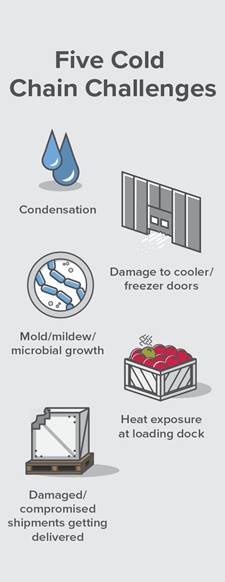- Home
- News
- Five Common Cold Chain Challenges
Five Common Cold Chain Challenges
Five Common Cold Chain Logistics Challenges
Companies in the cold chain industry have had decades to perfect the complex network used to keep cargo and products safe from the cold storage facility to its final destination. But as with any industry, there are challenges that can have serious safety and financial consequences, if not addressed.
While the challenges for any industry are seemingly endless and oftentimes unique, the following are five of the most common cold chain challenges you’ll face in your industrial and cold chain storage.

1. Damaged cooler/freezer doors
Cooler and freezer doors that are damaged are one of the most common problems cold storage facilities face. The initial impact of damaged freezer doors is that it can’t hold the specified temperature. Since that’s its main purpose, it’s a big deal.
Certain freezer door designs actively combat damage done by loading machinery. Look for tight sealing, impactable freezer doors that snap back onto their tracks if hit by a forklift. The GUI, included with every purchase of a cooler door & freezer door, tracks the number of times a door has opened and closed (due to impacts from a forklift or false activations without an object pass-through). Smart Data & Analytics collects that data tracked from the GUI and provides an in-depth analysis and recommendations for improving certain frequent events to help better manage energy as well as maintain security and safety at your facility.
If not addressed, the immediate consequence of damage to these cold storage industrial doors is spoiled product, but it can also lead to some of the other common issues in the cold chain that can affect worker safety, consumer safety and ultimately business relationships and your bottom line.
2. Condensation
Build up of condensation in coolers and freezers is a common problem in facilities where operations include both cool and warm processes. Products can generate excessive moisture if it moves from one temperature to the next too quickly. This can cause both slippery surfaces, affecting workers, as well as product adulteration that can create a health risk for consumers.
One of the best ways to mitigate and control condensation on food products is to use tools like HVLS fans to produce air flow in the facility to help regulate humidity levels and air flow.
3. Microbial Growth in the Freezer
Another common problem in industrial freezers is the growth of mold and mildew. Mismanaged temperatures or broken freezer doors can create this issue. If properly maintained, however, freezer walls will minimize microbial harborage and particulate build-up. Some of the best ways to prevent mold growth in industrial freezers include:
● Keeping freezers free from spills
● Tapering freezer surfaces
● Using lubrication-free components
If freezer mold becomes an issue, make sure to clean the freezer thoroughly to avoid any future problems that could affect both safety and the integrity of your cold chain output.
4. Excessive heat exposure
Sometimes the problem occurs before the temperature-sensitive item even makes it to the freezer or cooler. Prolonged exposure to warm outside temperatures during loading and unloading is a common problem that can degrade temperature-reliant foods, pharmaceuticals and other goods.
Implementing a drive-through dock design with a strong loading dock seal can avoid this cold chain problem by keeping the product away from the outside heat, preventing the safety hazards associated with temperature irregularities for sensitive products.
5. Damaged Goods
Even areas outside the immediate control of your cold storage facility, like receiving damaged shipments, can have a huge impact on profitability. There can be several problems with shipments in cold chain logistics, from broken products or exposing products to improperly warm temperatures in the trailer.
The best way to keep merchandise safe in transit is to use RFID tracking technology. This can alert recipients to this issue so they’re prepared to rectify the situation.
It’s essential that cold chain management take the proper steps to prevent these common temperature-controlled supply chain problems from occurring. Ensuring cold chain integrity, brand equity and consumer safety is paramount for any cold storage facilities operations. For a comprehensive discussion on these steps – and other cold storage best practices – download Rite-Hite’s Essential Guide to Cold Storage.
